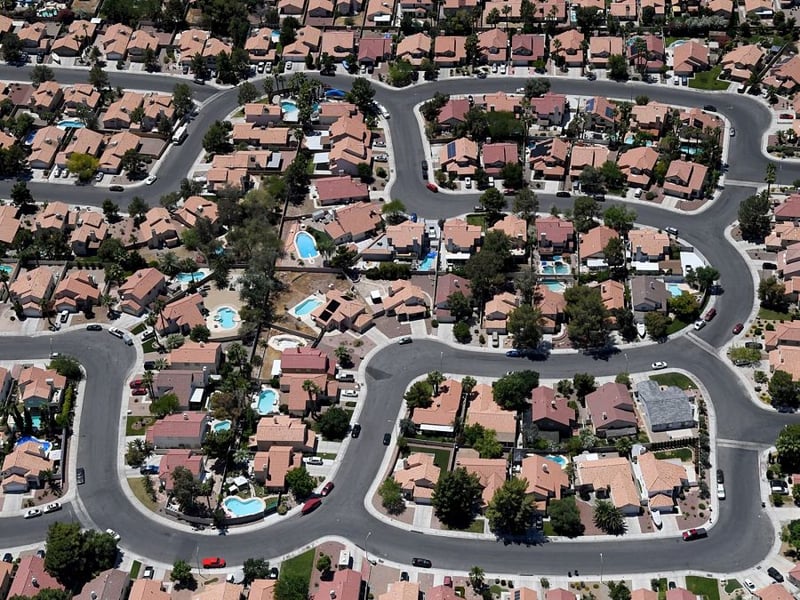When last year’s property slump reached its nadir, U.S. real estate lost nearly $3 trillion in value. As mortgage rates surged, buyers turned away in their hundreds of thousands, and sellers despaired.
Fast forward a few months and it looks as if property has bounced back — and bounced to a new record value. Buyers with long-term mortgages have realized that moving and getting a new mortgage would be the height of financial folly — and that means that there is a crippling shortage of available stock.
Real estate brokerage Redfin has crunched the numbers and calculates that real estate is now at a new highest-ever value of $47 trillion, eclipsing the previous peak of just over 12 months ago.
Home owners are “staying put because moving would mean taking on a rate that’s twice as high,” Redfin Economics research lead Chen Zhao said in a report released Friday. “This means buyers who are in the market now are duking it out for a very small pool of homes, preventing home values from plunging.”
KEY TRENDS
- U.S. home values increased 0.4% year-over-year in June and a staggering 19.1% in the last two years.
- The earlier $2.9 trillion dip due to rising mortgage rates between June 2022 to February 2023 has been neutralized.
- The current market is characterized by record-high home values amid reduced demand.
- Limited listings are due to homeowners not selling, with many not wanting to give up their low 3% mortgage rates acquired during the pandemic.
- This has intensified competition among buyers, preventing home values from dropping.
- 90% of homeowners have mortgage rates below 6%. Consequently, only 1% of homes have been sold this year, marking a decade low. Listings have decreased by 15%.
INTERNATIONAL COMPARISONS
- Unlike the U.S., where fixed-rate mortgages are dominant, other countries lean toward variable-rate mortgages, minimizing the “locked-in” effect.
WINNERS AND LOSERS
- According to Redfin Economics' Zhao, those who purchased homes before the rise in mortgage rates are benefiting. Conversely, first-time buyers face high borrowing costs and limited choices in a near-peak pricing market.
REGIONAL VARIATIONS
- Declines:
- Out of the 32 U.S. metropolitan regions that witnessed a drop in aggregate home value, 11 were in California and seven in Texas.
- Austin, Texas, saw the largest dip, at 9.6% year over year, with other significant drops in Seattle, San Francisco, Los Angeles and Oakland, California.
- Expensive markets like San Francisco and Seattle observed more pronounced reductions, partly as a result to remote workers relocating during the pandemic and tech sector layoffs.
- Gains:
- Affordable markets such as Little Rock, Arkansas, Camden, New Jersey, Milwaukee, Wisconsin, and Wilmington, Delaware, experienced the most significant jumps in home value, mainly because these areas have room to grow and homes are typically priced below the national median.
GENERATIONAL TRENDS
- Millennials:
- Their home value ownership grew by 2.9% year over year to $5 trillion in the first quarter.
- They've overtaken the Silent Generation in terms of home value.
- However, millennial home equity fell by 18.2% in the same period as they likely used their home equity to settle debts and fund renovations.
- Silent Generation: Saw an 11.4% reduction in owned home values due to natural attrition and shifts to retirement homes.
URBAN VERSUS SUBURBAN
- Urban home values declined by 0.9%, whereas suburban and rural home values rose by 0.2% and 2.6% respectively.
RACE AND HOME VALUE
- Homes in majority Asian neighborhoods dropped in value by 3.3%, partly attributed to a large West Coast residence, which experienced decreased home values.
PRICE RANGES
- Homes valued between $250,000 and $750,000 saw the biggest increases, while the luxury housing market, particularly in the West Coast, observed substantial declines.
RESEARCH METHODOLOGY
- The analysis utilized the Redfin Estimate, MLS data and public records. The Redfin Estimate covers more than 90 million varied properties, available in most U.S. regions. Historical values were based on price-per-square-foot trends. The data set includes both existing homes and new construction, tracking back to 2000.
- Categorization into rural, suburban or urban was based on HUD's model that classifies neighborhood types.
- Home values by race were determined through the five-year American Community Survey, classifying based on the majority race of owner-occupied households in a given census tract.
South Florida remains supreme for private real estate investors, says Participant Capital president







